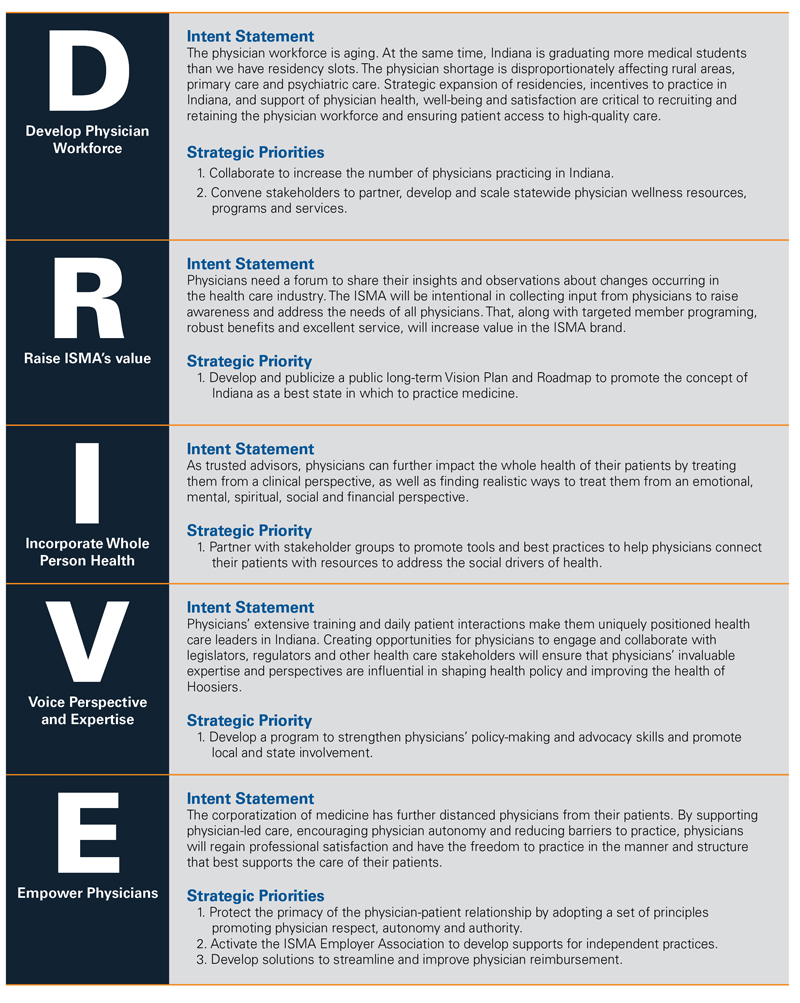The ISMA Board of Trustees recently unveiled a new three-year strategic plan, which expands the organization’s guiding principles and vision statement. In addition, updates to ISMA’s “DRIVE” strategic framework will be used to create a roadmap for making Indiana one of the best states in which to practice medicine – part of the association’s new vision statement.
ISMA’s updated strategic framework emphasizes:
- Growing the physician workforce.
- Supporting physician wellness.
- Helping to address social drivers of health.
- Supporting physicians who want to enhance their policy making and advocacy skills.
- Protecting the primacy of the physician-patient relationship.
- Reducing barriers to practice and fair reimbursement.
- Developing supports for independent practices.
“In the three years since ISMA’s last strategic plan was developed, Indiana’s health care landscape has changed significantly and vulnerabilities have been exposed,” said ISMA Executive Vice President Julie Reed, JD. “The COVID-19 pandemic took a physical and emotional toll on physicians, further straining the workforce and deepening shortages. Physicians witnessed the effects social drivers have on their patients’ overall health. And an independent study put a magnifying glass on the inequities of Hoosier physician reimbursement.”
The board worked with health care consultant Karen Porter of KLPorter Strategic Solutions on the six-month strategic planning effort. A key part of the process was to send a survey to all ISMA physician and student members with valid email addresses, as well as to nonmember physicians. There were five open-ended questions:
- What are the most important trends or changes occurring within the health care industry that could or will adversely affect physicians?
- What changes could be made to the medical profession or health care industry to make Indiana a better (or the best) state in which to practice medicine?
- What changes could be made to physician lifestyles or quality of life to make Indiana a better (or the best) state in which to practice medicine?
- What characteristics would make Indiana a better (or the best) state in which a patient could receive care?
- How will we know if ISMA is successful?
“It was really important to us to learn what was on the minds of our members, and we are extremely grateful that they took the time to provide us invaluable feedback,” said David R. Diaz, MD, former board chair and current ISMA president-elect. Dr. Diaz noted that more than 500 responses were received in just over two weeks, including 140 pages of comments.
Board members met March 5 for a strategic planning retreat led by Julie Reed and Karen Porter. They discussed the survey responses and focused on what role ISMA could play in three key focus areas: Physician workforce, the business of medicine, and patient care/public health. Those outputs were organized into a plan the board reviewed multiple times and approved in July; it was published to the House of Delegates in September. Now, ISMA staff is developing an implementation plan.
“The survey responses were passionate and emotional,” said Reed. “Physicians want to feel supported to do what they were trained to do – take care of their patients – without interference and unnecessary burdens. Our goal is to help them achieve that.”
MISSION
The Indiana State Medical Association exists to maximize the leadership and impact of physicians.
VISION
Indiana will be one of the best states in which to practice medicine, and Hoosiers will be among the healthiest people in the country.
GUIDING PRINCIPLES
- Quality health care depends on access to physician-led care.
- Physician well-being and fulfillment must be priorities in health care environments.
- Physician impact increases as administrative barriers are reduced.
- Patients benefit from having access to a diverse physician workforce.
- Improving the health of individuals improves the health of society.
- The whole health of individuals depends on socioeconomic factors, physical environment, health-related behaviors, medical conditions and medical care.
- Together, physicians can effect positive change better than they can individually.
